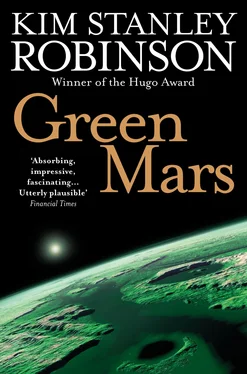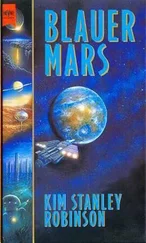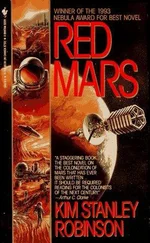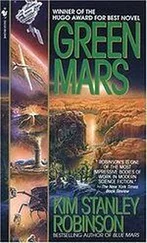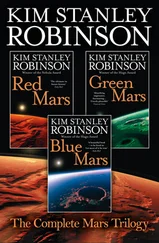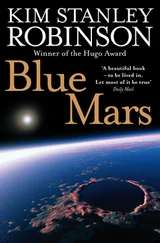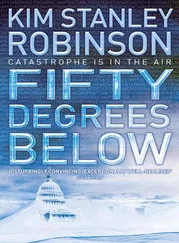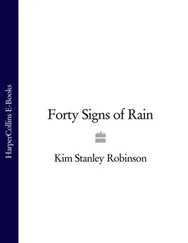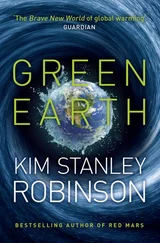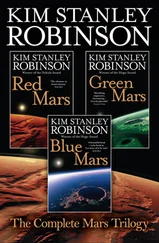So the first day’s drive was all downhill, but Art’s spirits remained high. “Toto, there is no chance we are in Kansas any more. We’re … off to see the wizard ! The wonderful wizard of Mars!”
The road paralleled the fall line of the cable. The cable had hit the west side of Tharsis with a tremendous impact, not as great as during the final wrap of course, but enough to create the interesting superbuckies Art had been sent out to investigate. The Beast he was going down to meet had already salvaged the cable in this vicinity, however, and the cable was almost entirely gone; the only thing left of it was a set of old-fashioned-looking train tracks, with a third cog rail running down the middle. The Beast had made these tracks out of carbon from the cable, and then used other parts of the cable, and magnesium from the soil, to make little self-powered cog rail mining cars, which then carried salvage cargo back up the side of Pavonis to the Ouroborous facilities in Sheffield. Very neat, Art thought as he watched a little robot car roll past him in the opposite direction, up the tracks toward the city. The little train car was black, squat, powered by a simple motor engaging the cog track, filled with a cargo of carbon nanotube filaments, and capped on top by a big rectangular block of a diamond. Art had heard about this in Sheffield, and so was not surprised to see it. The diamond had been salvaged from the double helixes strengthening the cable, and the blocks were actually much less valuable than the carbon filament stored underneath them—basically a kind of fancy hatch door. But they did look nice.
On the second day of his drive, Art got off the immense cone of Pavonis, and onto the Tharsis bulge proper. Here the ground was much more littered than the volcano’s side had been with loose rock, and meteor craters. And down here, everything was blanketed with a drift of snow and sand, in a mix that looked like equal shares of both. This was the firn slope of west Tharsis, an area where storms coming in from the west frequently dumped loads of snow, which never melted but instead built up year by year, packing down the snow on the bottom. So far the pack consisted only of crushed snow, called firn, but a few more years of compaction and the lowest layers would be ice, and the slopes glaciers.
Now the slopes were still punctuated by big rocks sticking out of the firn, and small crater rings, the craters mostly less than a kilometre across, and looking as fresh as if they had been blasted the day before, except for the sandy snow now filling them.
When he was still many kilometres away, Art caught sight of the Beast salvaging the cable. The top of it appeared over the western horizon, and over the next hour the rest of it reared into view. Out on the vast empty slope it seemed somewhat smaller than its twin up in East Sheffield, at least until he drove under its flank, when once again it became clear that it was as big as a city block. There was even a square hole in the bottom of one side which looked for all the world like the entrance to a parking garage. Art drove his rover right at this hole—the Beast was moving at three kilometres a day, so it was no trick to hit it—and once inside, he drove up a curving ramp, following a short tunnel into a lock. There he spoke by radio to the Beast’s AI, and doors behind his rover slid shut, and in a minute he could simply get out of his car, and go over to an elevator door, and take an elevator up to the observation deck.
It did not take long to realise that life inside the Beast was not the essence of excitement, and after checking in with the Sheffield office, and taking a look at the ion chromatograph down in the lab, Art went back out in the rover to have a more extensive look around. This was the way things went when working the Beast, Zafir assured him; the rovers were like pilot fishes swimming around a great whale, and though the view from the observation deck was nice and high, most people ended up spending a good part of their days out driving around.
So Art did that. The fallen cable out in front of the Beast showed clearly how much harder it had been coming down here than it had back at the start of its fall. Here it was buried to perhaps a third of its diameter, and the cylinder was flattened, and marked by long cracks running along its sides, revealing its structure which consisted of bundles of bundles of carbon nanotube filament, still one of the strongest substances known to materials science, though apparently the current elevator’s cable material was stronger yet.
The Beast straddled this wreckage, about four times as tall as the cable; the charred black semi-cylinder disappeared into a hole at the front end of the Beast, from which came a grumbling, low, nearly subsonic vibration. And then, every day at about two in the afternoon, a door at the back of the Beast slid open over the tracks always being excreted from the back end of the Beast, and one of the diamond-capped train cars would roll out and glide off toward Pavonis, winking in the sunlight. The trains disappeared over the high eastern horizon (into the apparent “depression” now between him and Pavonis) about ten minutes after emerging from their maker.
After viewing the daily departure, Art would take a drive in the pilot fish rover, investigating craters and big isolated boulders, and, frankly, looking for Nirgal, or rather waiting for him. After a few days of this, he added the habit of suiting up, and taking a walk outside for a few hours every afternoon, strolling beside the cable or the pilot fish, or hiking out into the surrounding countryside.
It was odd-looking terrain, not only because of the even distribution of millions of black rocks, but because the hard blanket of firn had been sculptured into fantastic shapes by the sand-blaster winds: ridges, boles, hollows, tear-shaped tailings behind every exposed rock, etc. Sastrugi, they were called. It was fun to walk around among these extravagant aerodynamic extrusions of reddish snow.
Day after day he did this. The Beast ground slowly westward. He found that the windswept bare tops of the rocks were often coloured by tiny flakes that were scales of fast lichen, a kind that grew quickly, or at least quickly for lichen. Art picked up a couple of sample rocks, and took them back into the Beast, and read about the lichen curiously. These apparently were engineered cryptoendolithic lichens, and at this altitude they were living right at the edge of the possible—the article on them said that over ninety-eight percent of their energy was used simply to stay alive, with less than two percent going toward reproduction. And this was a big improvement over the Terran template species.
More days passed, then weeks; but what could he do? He kept on collecting lichen. One of the cryptoendoliths he found was the first species to survive on the Martian surface, the lectern said, and it had been designed by members of the fabled First Hundred. He broke apart some rocks to have a better look, and found bands of the lichen growing in the rocks’ outer centimetre: first a yellow stripe right at the surface, then a blue stripe under that, then a green one. After that discovery he often stopped on his walks to kneel and put his faceplate to coloured rocks sticking up out of the firn, marvelling at the crusty scales and their intense pale colours—yellows, olives, khaki greens, forest greens, blacks, greys.
One afternoon he drove the pilot fish far to the north of the Beast, and got out to hike around and collect samples. When he returned, he found that the lock door in the side of the pilot fish would not open. “What the hell?” he said aloud.
It had been so long that he had forgotten that something was supposed to happen. The happening had taken the form of some kind of electronic failure, apparently. Assuming this was the happening, and not … something else. He called in over the intercom, and tried every code he knew on the keypad by the lock door, but nothing had any effect. And since he couldn’t get back in, he couldn’t turn on the emergency systems. And his helmet’s intercom had a very limited range—the horizon, in effect—which down here off Pavonis had shrunk to a Martian closeness, only a few kilometres away in all directions. The Beast was well over the horizon, and though he could probably walk to it, there would be a section of the hike where both Beast and pilot fish would be over the horizon, and himself alone in a suit, with a limited air supply …
Читать дальше
